Storage
• Water: Heat storage is usually accomplished with plain water or a water glycol antifreeze mixture.
Water is inexpensive or free, and plentiful. It has the highest heat capacity per pound among the commonly used materials, and because its molecules flow freely among themselves, the heat it holds is distributed evenly by convection (see “How Heat Moves”).
However, using water as a solar heat storage medium also has its disadvantages. Convection distributes the water’s heat evenly, but it also evens out the temperatures throughout the storage tank. So as temperatures fall on one side, they also begin to fall on the other—and all through the middle as well. Therefore heat loss through out the entire water tank occurs faster than in a rock bin.
The introduction of high-quality plastic waterproof liners has diminished the problem of leakage from poured concrete tanks, just as the use of glass tank lining has minimized problems with corrosion in domestic hot water systems. But these improvements have also led to an increase in the initial cost of water storage systems.
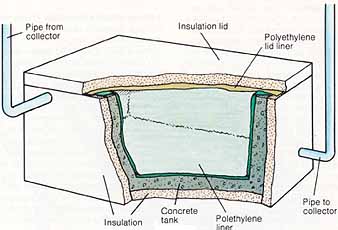
Concrete Cater Storage Tank
• Tank size: As a rule of thumb, experts say that you need anywhere from one to two gallons of water storage per square foot of collector to fill 75 percent of your heating needs; or that you need about one gallon of water per square foot of space to be heated; and so forth. Actually, there are many variables that dictate the size of a water tank suitable for your heating needs. One is the amount of heat you require, and this must be matched with the amount of heat that can be stored and the rate at which it is released. These calculations should be made by experienced solar architects and engineers.
Including a concrete shell, the filled tank can easily weigh five, ten, or fifteen tons. If you can build it in as an integral part of your basement, you have probably found the ideal location for the tank. If not, you will probably still place the tank in the basement, to prevent undue strain on your floorboards. If your basement is unheated, or if the tank abuts any exterior walls, it is particularly important to pay attention to proper insulation.
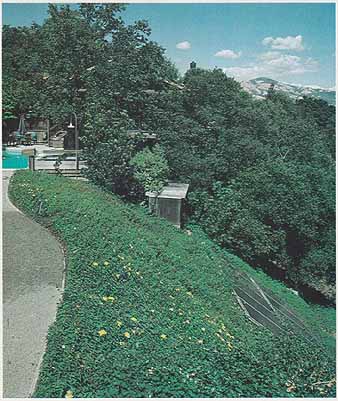
Solar collectors can also be set right into the ground if you have
a hillside that is conveniently sloped to take advantage of the sun. Such
placement is particularly usable for swimming pool solar heat collectors,
because they have less need than other collectors to face directly into
the sun, and their orientation and tilt need not be as specific.
• Rock: Like water, rock is cheap or free, and plentiful—although its abundance should not encourage you to go rock-picking as a do-it-yourself mea sure in building your rock bed storage bin. You can count on this bin occupying about three times the space a solar water storage tank would occupy. We are talking about a lot of rocks.
Cubic foot for cubic foot, water retains heat about twice as well as rock. But rock loses heatless quickly than water does, since heat doesn’t circulate as directly through a pile of rocks as it does in a tank of water. Although one side of a rock bin may lose all its heat, the other will remain completely warm. This means that even if one side of the bin has cooled, you can still pick up heat from the other side. and unlike a water tank, nothing in a rock-bed storage bin will freeze, leak, rust, or corrode, nor is any part of the bin itself likely to wear out. Like a water tank, a rock bin must be insulated—and it must also be kept dry inside to discourage mildew. On the other hand, since rock gives up its heat more slowly than water, it is possible that the rate of your demand for heat may be greater than the rate at which the rocks give up their heat. The fact that water cools down faster also means that the heat stored there is given off faster and is, therefore, more available when demand is high. Again, the choice between rock and water will include all the variables of your particular situation, which should be discussed with an experienced solar expert.
Only air systems can make use of rock-bed heat storage. The cool air can simply be ducted or blown over the storage unit, picking up heat along the way, and then be sent on through the sys tem to heat the house. Or the air may be allowed to circulate through the storage bin before being ducted out.
Rock-bin storage requires enormous volume, and the weight of a storage unit is impressive. Depending on all the variables, you may need 100 to 400 pounds of 1 - to 4-inch rocks per square foot of collector area to maintain normal house hold temperatures. Whether you build your storage unit into a basement or into a crawlspace, it must be provided with a very secure and well-insulated foundation.
• Phase-change materials: These heat- storage materials change their form as the temperature changes. The most common material is eutectic salts. These are extremely efficient heat-storage materials for their size and weight. They melt at low temperatures, and , at nor mal household temperatures, they absorb approximately two to four times as much heat as their weight in water, or up to twenty times their weight in rock. The smaller size considerably reduces the storage area needed, and the lighter weight allows you to use the materials in many locations, not just in a basement, crawlspace, or other heavily supported structure. To date, however, the problems with eutectic salts have made them impractical for solar heat storage.
Eutectic salts are prohibitively expensive in the necessary quantities, and their performance decreases markedly when temperatures rise or fall very much beyond the useful indoor range, making storage of fluctuating solar heat awkward. When they cool, they solidify only partly, causing a progressive breakdown over numerous phase- changes from solid to liquid and back to solid, which decreases their long- term efficiency.
Research is in progress which, it is hoped, will improve the stability of eutectic salts; but for the time being they are more on the leading edge of solar technology than in the practical mainstream.
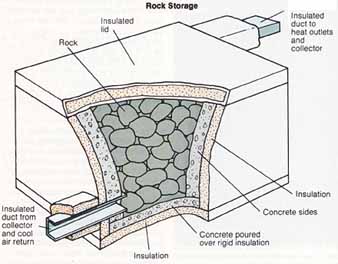
Rock Storage: Insulated duct from collector and cool air return;
Insulated duct to heat outlets and collector; Concrete poured over rigid
insulation; Concrete sides; etc.
Distribution
Once the heat is collected and stored for later use, you still have to get it up into the house. Passive solar heating systems generally incorporate distribution as a natural extension of their collecting and storing properties. Active systems, however, are designed for greater user control. They demand pipes and perhaps heat exchangers for liquid systems, and ducts, fans, and blowers for air systems. and in almost every area of the United States, either system must connect with an auxiliary backup heating system.
Your auxiliary heating is your fail safe device. Since solar heat can't yet be relied on to fill all your heating needs, you want to know that you can stay warm when the cold winds blow under cloudy skies for a week at a time. If you live in a generally mild climate, your auxiliary heat might be a few electric space heaters. If you live where wood is plentiful and easy to bring home, an efficient stove or fire place may provide your backup (see Wood and Other Alternatives”). But for most houses, auxiliary heating means the kind of full-bore conventional system that probably heats your house today—gas, oil, or electric. It can be operated separately from your solar system, making you responsible for turning it on when the time is right. Or your contractor should be able to connect the systems in such a fashion that all you need to do is maintain a constant thermostat setting; when your solar storage cools down from lack of sun, your auxiliary furnace will start up automatically.
In most cases, your existing ducts or pipes can be used to distribute solar heated air. Occasionally, you may prefer larger ducts because solar heat is usually lower than furnace heat, requiring the movement of more air to achieve the same level of comfort throughout the house. Further, depending on the degree of heat your system delivers, the current placement of heating ducts in your house may be less effective for solar heat than for your existing system. But for the most part, you can install solar components that can be connected to your existing distribution system.
This means that if you have a boiler, you are not required to install a water system. In fact, water systems demand particularly high collection and storage temperature to distribute their heat through baseboards, which can make the system somewhat inefficient. On the other hand, forced air systems operate at lower temperatures and can be more effective. You will want to ex amine all the alternatives for heat and cost-effectiveness to determine which will best meet your needs.
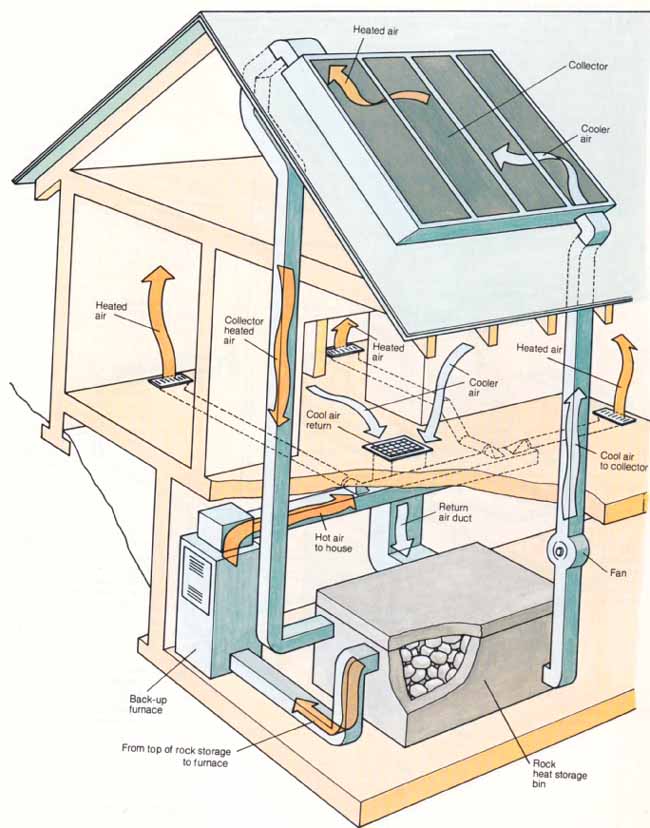
Air Heating System: From top of rock storage to furnace; Back-up
furnace; etc.
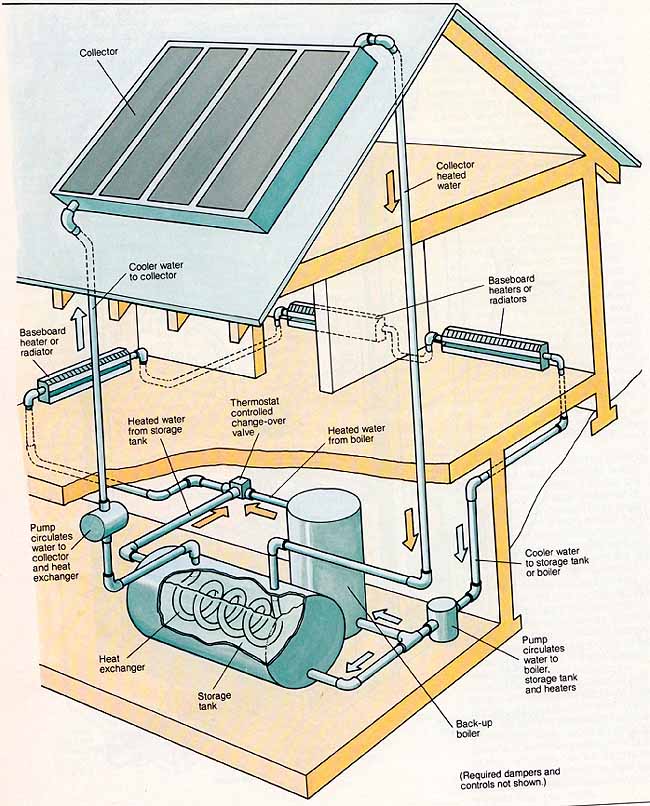
Pump circulates water to boiler, storage tank and heaters; Back-up boiler
Next: Domestic Hot Water; Bread Box Collector; Thermosiphoning Systems